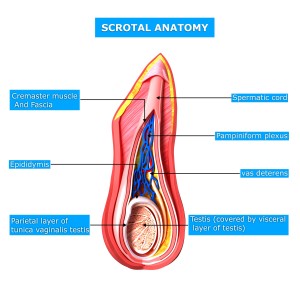Epididymal cysts are fluid filled sacs that develop in the Epididymis (where sperm from the testis collect before moving along the vas). They occur for a number of reasons but are always benign and generally cause mild discomfort only. They are not known to be associated with cancer.

Epididymal Cysts may be identified as scrotal lumps, found on physical examination by a physician. They may also be discovered by self-inspection of the scrotum and testicles.
They are usually painless, located at the head of the epididymis (just above the testicle) and can be clearly felt separately to the testicle. If uncertainty exists, an ultrasound of the scrotum can confirm the diagnosis. A lump WITHIN the testicle itself is much more concerning as it could represent testicular cancer – if you feel a lump within the testicle please see your GP or urologist.
Epididymal cyst removal or excision is a procedure to remove these cysts from the scrotum. An alternative to open surgery is to drain the fluid with a needle under ultrasound guidance. Both procedures are effective in the short term, but the cysts are much more likely to come back after needle drainage.
Removal of the cysts is performed under a general anaesthetic.
The surgeon makes an incision in the area, removes the cyst, and closes the opening in the Epididymis and then the skin with absorbable stitches. This is a fairly quick procedure and most patients are able to go home after a few hours of recovery in the hospital. Rest, antibiotics, and pain medication are usually recommended once the patient is discharged. Full recovery may take 7 to 10 days. Some patients may not be candidates for surgery. Smokers and overweight patients are at a higher risk. Similarly, men with blood pressure, heart, or lung problems should check with their doctors before pursuing the removal under general anaesthetic.
Small cysts are best left alone. Only when the cysts are causing discomfort and are enlarging in size should surgery be considered. It is important to remember that in some situations pain may persist even after removal of the cyst as there may be other conditions in the scrotum causing the pain.
This is when problems occur during or after the operation. Complications are uncommon but include an unexpected reaction to the anaesthetic, infection, excessive bleeding or developing a blood clot, usually in a vein in the leg (deep vein thrombosis, DVT).
Specific complications of epididymal cyst surgery are very uncommon, but include:
Click Here for postoperative instructions after excision of epididymal cysts